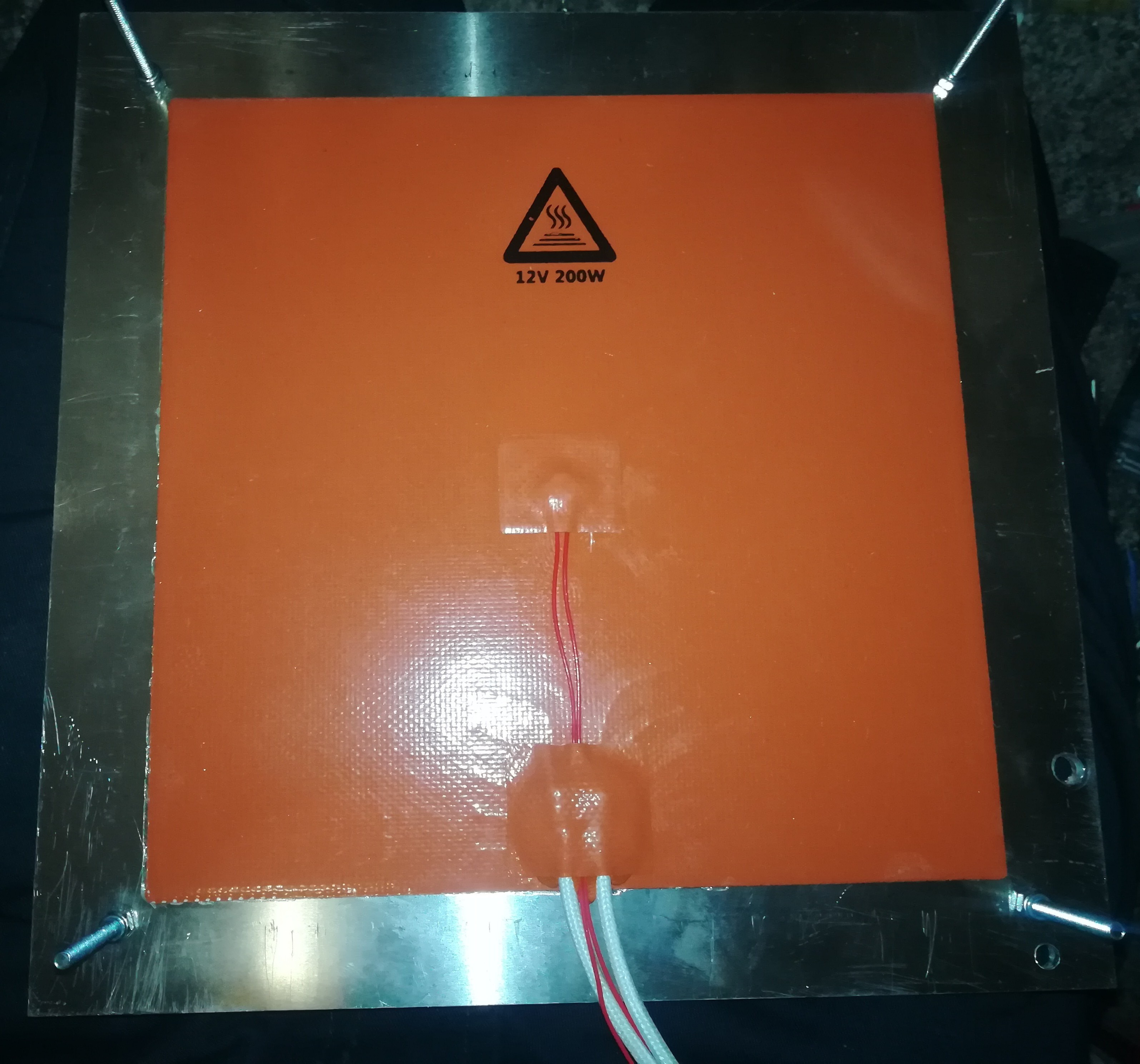I added a heated bed to the printer to reduce the temperature loss through the buildplate, which could maybe help with adhesion and reduce warping of the steel surface underneat the printed object.
Wheater it helps or not is pure speculation, but some people told me it would help and I thought so, too. And so I tested two different heating designs.

First I tested an induction heating design for reaching the highest possible temperature without radiating heat to the rest of the printer. The design consists of a power supply, a ZVS driver and the induction coil.
The induction coil is made of a AWG 10 silicone cable which is rated up to 200°C which lays on a PTFE plate which is rated up to 260°C. The coil is coverd with stovepipe access door sealing which is rated up to 1100°C to prevent the cable from touching the buildplate.
Unfortunately there are some problems, which maybe make the design a bad candidate for buildplate heating, until I can find a solution to them.
First I tested it with 12V, which draws 340W max, which heated the plate to around 100°C. I measured the themperature with an IR thermometer, but got no usable reading. It indicated room temperature, even though I could boil water (Still don't know why I got this false reading). So I used a barbecue thermometer.
Next I tested with 24V and this is where the problems started. With 24V and the buildplate direct above the coil it draws more than 800W, what shuts down my 600W power supply, from which I thought it could deliver more than enough power....
So I tested elevating the buildplate some millimeters above the coil, until it only draws around 500W - what worked.
With 500W the plate reached above 250°C, which was the highest value the barbecue thermometer could read and after some time the carbon steel plate changed its color above the coil and begun to bend. The PTFE plate underneat the coil started bending, too. So I stopped testing and measured the temperature of the coil which was around 190°C - very close to the limit.
I think for now these are not the right conditions for safe and reliable operation and so I tried a second approach.

It's a 12V 200W silicone heat pad which is rated up to 190°C, but the 468MP double sided tape at its back is ony rated up to 150°C, so that is the limit for it until I use silicone glue or something with a higher temperature rating.
I tested it for a short time and it reached 80°C on the buildplate with 100°C on the heater. I think if I had waited longer, it would have reached 100-120°C or more on the buildplate. Next time I will test it for longer.
So the bed is now heated - Maybe the print can benefit from it, maybe not, I will see with further testing.
Update:
I figured out that the problem with the object not sticking to the buildplate was caused by bad first layer quality and heating until the part unwelds itself from the buildplate when the head crashes into the part. So it seems likely heating the buildplate is unnecessary and I will maybe end up not using it at all.
A small setback that heating the buildplate has turned out as not worth it, but at least I tested it out...
 Dominik Meffert
Dominik Meffert
Discussions
Become a Hackaday.io Member
Create an account to leave a comment. Already have an account? Log In.
Progress is when everybody says that something can't be done or is stupid and one person thinks differently. It takes many many mistakes to find that one good path, but if you don't take bad paths you won't find good one, so: Thanks for checking if heated build plate will work.
Are you sure? yes | no
Thank you for your comment :)
The problems I noticed were:
With induction it could reach very high temperatures, but it draws a lot power and needs higher voltage than the other components of the printer, so it would need an additional power supply or a voltage converter for the other electronics and due to the heat created in the silicone cable, the cable itself and ptfe plate overheats at >250°C. The printbed surface reachs intended even higher temperatures, but it bends due to not uniform heating (much higher temperature underneat the induction coil than on the edges). I could use High Frequency Litz Wire which could maybe solve the problem with cable and ptfe plate overheating, but the bending remains - Think it could be solved with a coil which covers the whole heatbed, but also the work current cable insulation overheats at even lower temperatures - Which could be solved by removing the insulation and covering it with heat protection tubing.
With the normal silicone heatpad it takes a lot of time to heat up and still overheats the work cable insulation.
In addition, i could not see any difference in print quality/adhesion between the build plate heated to around >250°C or the buildplate not heated at all.
Therefore I came to the conglusion that heating the buildplate is not necessary at the moment.
Are you sure? yes | no